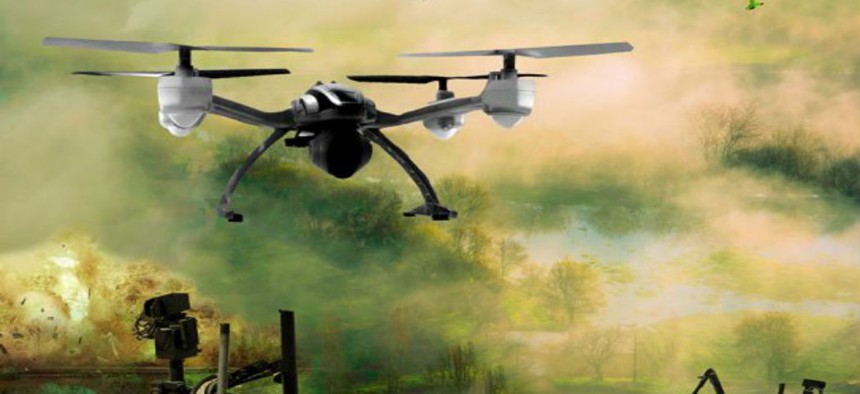The Army drone software processes undersea terrain, creates cloud-based 3D maps
The 2017 AUSA Meeting and Expo showed drone technology that can map 3D underwater terrain and turn video in 3D models.
Researchers with the Army’s Engineer Research and Development Center (ERDC) unveiled new drone surveillance technology that can map underwater terrain and create cloud-accessible 3-D mission area maps at the 2017 Association of the U.S. Army (AUSA) Annual Meeting and Exposition.
The ERDC research teams revealed three different drone frameworks in development: a hovering drone, a mobile drone, and a tethered drone.
According to an ERDC researcher, the hovering drone has a range of about one km and an endurance of about 30 minutes. It is designed to be launched from a ship in order to survey amphibious landing zones without sending soldiers into contested beach zones. The mobile drone has a range of 10 km and is designed to provide an overview of an entire amphibious area to help commanders determine the best landing zone.
The tethered drone garnered the most attention as the first test-platform for underwater and cloud-based 3D mapping technology. Like the hovering drone, the tethered drone has a range of about one km, and is being developed for ship-based and land-based surveillance, reported the ERDC researcher.
Launched from an amphibious assault vehicle or a two-person boat team, the tethered drone can collect data on tide shifts and underwater topography of a proposed landing zone. Using LIS-Swift System software paired with low-power radar, the drone can collect enough data in about ten minutes to inform operators of water depth and underwater terrain, reports the ERDC.
In terms of land surveillance, the tethered drone takes still-frame photographs of the contested area and then uploaded on a ruggedized laptop device using photogrammetry software. The program creates a rapid real-time image of the terrain, which includes elevation levels of buildings in urban environments, according to published statements by Soldier-Deployable Geospatial Technologies (SDGT).
Another version of the drone, the mapping micro unmanned airborne systems (Micro-UMS) is disposable, weighing only one and a half pounds with a flight time of 45 minutes, according to SDGT statements. The fixed wing drone can take still-frame images or full motion video (FMV) recordings, which can then be processed using FMV-to-3D conversion software.
The software compiles the video feed data to build a 3D model that is stored in a cloud-like multi-accessible domain. According to the ERDC, the 3D map can then be accessed by multiple personnel, who can change their viewing angle and perspective on the model without losing its integrity.
The software can also create terrain models based on Digital Elevation Data, Passive 3D point clouds, and textured 3D models, reported SDGT. Finally, the program provides a 2D orthomosaic, or a map that contains latitudinal and longitudinal data and color for each point, at a standardized scale.
So far, the lightweight drone has been used by the 2nd Brigade Combat Team, 101st Airborne Division in a mission set of 6 sorties. The hundreds of images were then successfully processed into a real-time urban model, according to the Army press release.
It is not known when the more advanced software and drone technology will reach the battlefield, however the ERDC describes the projects presented at the 2017 AUSA Expo as significant advances.




